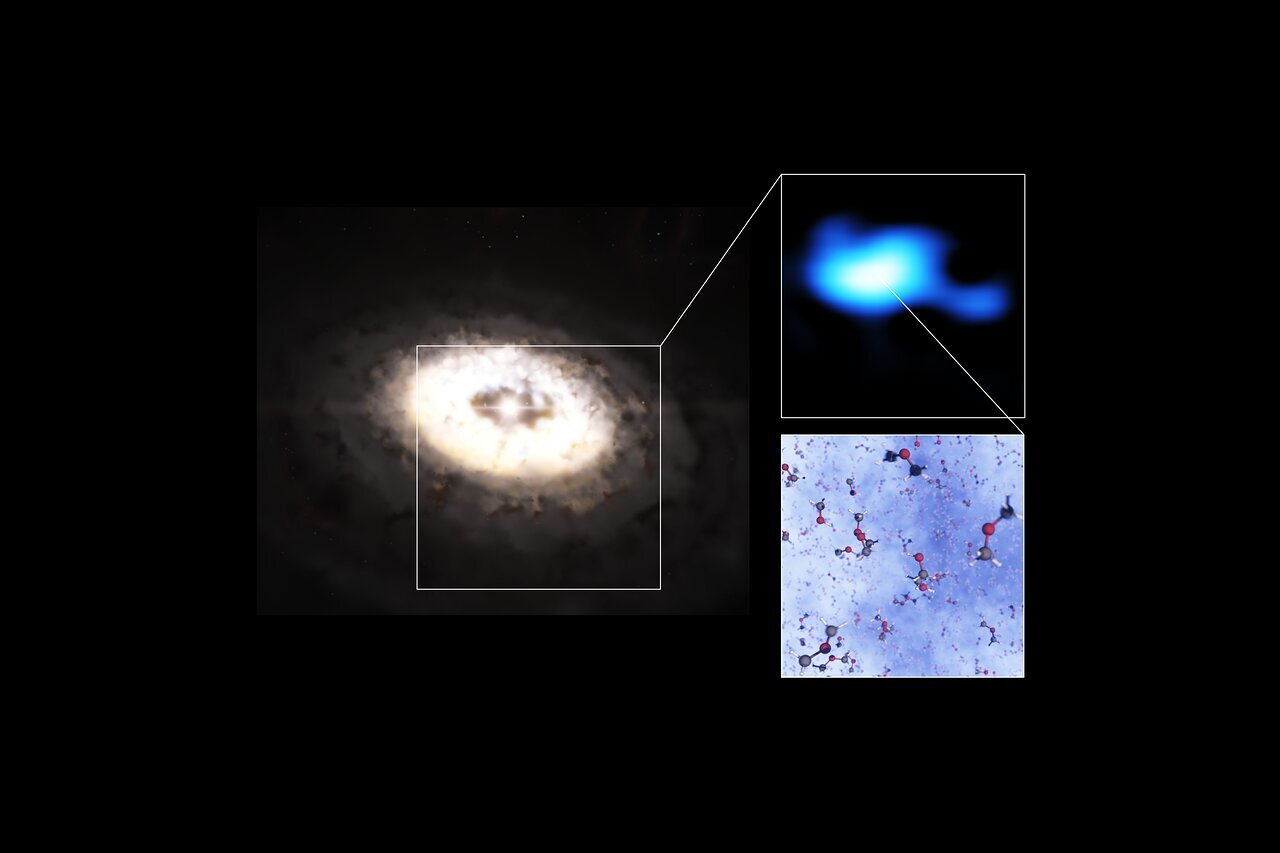I did some more digging into this disk report and molecule. Here is what I found.
Using the Atacama Large Millimeter/submillimeter Array (ALMA) in Chile, researchers at Leiden Observatory in the Netherlands have for the first time detected dimethyl ether in a planet-forming disc. With nine atoms, this is the largest molecule identified in such a disc to date. It is also a...

phys.org
"Using the Atacama Large Millimeter/submillimeter Array (ALMA) in Chile, researchers at Leiden Observatory in the Netherlands have for the first time detected dimethyl ether in a planet-forming disc. With nine atoms, this is the largest molecule identified in such a disc to date. It is also a precursor of larger organic molecules that can lead to the emergence of life."
This report caught my attention this morning. My observation. To extrapolate from these observed molecules in a dust disk to the origin of life is more than a stretch. How did the molecules remain intact when the disk collapses into planets and bombardment and intense impacts take place to create a planet(s)? Also I did not see the mass size of IRS 48 disk reported (but an older report shows this, about 191 earth mass around a 2 solar mass star, Oph IRS 48). How does the disk mass compare to the MMSN? Are there reports of rings in the disk?
Reference paper, A major asymmetric ice trap in a planet-forming disk,
https://www.aanda.org/articles/aa/full_html/2022/03/aa42981-21/aa42981-21.html, March 2022, “1 Introduction Complex organic molecules (COMs) are the precursors of prebiotic molecules, and thus understanding their formation and evolution will help us gain more insight into how life originated in our own Solar System (Caselli & Ceccarelli 2012)."
The paper clearly pushes belief in abiogenesis for the origin of life but fails to show how such molecules survive the catastrophic planet formation process only later, to evolve into life on a planet. I did some rummaging around using MS BING and found these reports.
"Why is IRS 48 so important?
Because the disk around the star, named IRS 48, will clump together to form exoplanets, the discovery of the molecule could have important implications for our understanding of how life emerges in the Universe."
"In this swirling cloud, astronomers detected the signature of dimethyl ether, a molecule that contains nine atoms. This oxygen-bearing molecule can act as a building block for sugars and other biomolecules, which means we can consider it a prebiotic compound. Because the disk around the star, named IRS 48, will clump together to form exoplanets, the discovery of the molecule could have important implications for our understanding of how life emerges in the Universe. "From these results, we can learn more about the origin of life on our planet and therefore get a better idea of the potential for life in other planetary systems," says astronomer Nashanty Brunken of Leiden University in the Netherlands."
I did find the disk mass reported in the reference cited in the msn.com link. "2. Observations Oph IRS 48 is an A0 star located in the Ophiuchus cloud at a distance of 135 pc (Gaia Collaboration 2018). This disk, inclined at 50°, shows an asymmetric millimetre-dust concentration at 60 au, in contrast with a full ring in gas, as well as small dust grains (van der Marel et al. 2013), and it has an estimated gas disk mass of only 0.6 MJup (van der Marel et al. 2016). IRS 48 was observed using ALMA in Band 7 in polarization mode in Cycle 5 in August 2018 (2017.1.00834.S, PI: Adriana Pohl).", ref link
https://www.aanda.org/articles/aa/full_html/2021/07/aa41051-21/aa41051-21.html, A major asymmetric ice trap in a planet-forming disk, July 2021.
0.6 Mjup is very small compared to the MMSN of some 3300 earth masses (total dust and gas), about 191 earth masses. How such molecules survive the accretion process and large scale bombardments and impacts said to take place during accretion of planets in a spinning disk, I do not see covered. Oph IRS 48 is said to be an A0 star in Ophiuchus *star forming cloud*. An A0 star could be at least 2 solar masses so the MMSN applied here, results in a disk mass 6.658855E+03 or 6659 earth masses as a minimum. 191 earth mass disk is very small. The NASA ADS reports show the star mass is 2 Msun and the disk mass of 0.6 Mjup.
Here are some NASA ADS Abstract reports on Oph IRS 48. A major asymmetric ice trap in a planet-forming disk: III. First detection of dimethyl ether,
https://ui.adsabs.harvard.edu/abs/2022arXiv220302936B/abstract, March 2022. A major asymmetric ice trap in a planet-forming disk. I. Formaldehyde and methanol,
https://ui.adsabs.harvard.edu/abs/2021A&A...651L...5V/abstract, July 2021. The arxiv paper link shows the disk mass 0.6 Mjup.
So here is my simple summary of Oph IRS 48 after digging a bit more. We have a 2 solar mass star that is young with a disk mass of about 191 earth masses (very small compared to the MMSN applied to 2 solar mass star) containing some molecules in the disk that could lead to the origin of life assuming abiogenesis, non-living matter containing chemicals necessary for life that were seeded from the accretion disk when the planet formed. Somehow the accretion process does not destroy the molecules or obliterate during the accretion phase (or perhaps it does), bombardment and impact phases. Somehow after all the catastrophic planet building is over in the disk and the planet cools down, non-living matter recombines to create life.
Charles Darwin letters from early 1880s and his warm little pond is very different for abiogenesis than finding molecules in disks around other stars that are said to collapse and form planets and later, life appears on some. Today's science progressed and changed much concerning the origin of life from non-living matter as Charles Darwin postulated.



